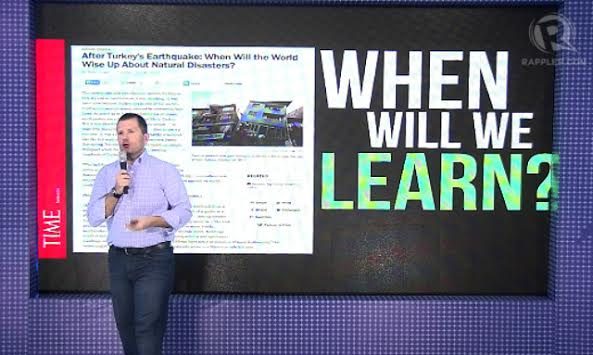SUMMARY
This is AI generated summarization, which may have errors. For context, always refer to the full article.

MANILA, Philippines – With no country safe from natural disasters, awareness on their consequences and the kind of response needed to address them has spread fairly quickly with the help of technology and the Internet.
But a talk at the 2014 PH+Social Good Summit in Taguig City ventured to deepen understanding on natural calamities.
Beyond rising death tolls and first response, what decisions determine how destructive calamities are and what does it take really take to make a full recovery?
The talk, entitled “Climate Change and Disasters,” began with words from Philippine Climate Change Commissioner Lucille Sering who contextualized natural disasters against the larger backdrop of climate change.
“Climate change and disaster risk reduction are closely interrelated. We cannot effectively reduce risks without adapting to climate change,” she said.
At the root of climate change is the world’s unsustainable energy sources: fossil fuel-derived energy that lead to the emission of gigatons of greenhouse gases.
As the world battles to keep global temperatures from warming by more than 2 degrees C (they are now at 0.85 degrees C), the need to shift to greener, renewable sources of energy is more urgent now than ever, said Sering.
Making the shift is easier than we think, she said, using her own experience of installing solar panels to power her home.
“We need to embrace new ideas, support technologies that will help us improve energy usage. We need to have a climate of change if we want to address climate change.”
The right incentives
Political scientist Jason Enia from Sam Houston State University delved deeper into the politics of disaster and how the right policies and incentives can make or break both disaster preparedness and recovery.
Disaster officials make policies with a set of incentives to produce positive outcomes, but many times, these policies have unintended consequences because of the wrong incentives, he said.
For instance, flood insurance in the United States aims to help American families recover from calamities. As such, the government and insurance companies strove to drive down insurance premiums to encourage more families to avail of the insurance.
But a look into the policy and incentives showed that putting more households under flood insurance did not address the root of the problem: citizens exposed to flooding.
A better solution would be to incentivize families not to live in flood-prone areas in the first place, Enia said.
What does this mean for concerned citizens, journalists and leaders?
“We need to do a better job of paying attention to unintended consequences of policies. A lot of the crowdsourcing technologies can give us early insights into how people will respond to policies,” said Enia.
By digging deeper and smarter into policies and their outcomes – whether intended or not – those in power can be convinced to rethink policies and come up with better ones.
Watch Enia’s talk below.
On the ground after Yolanda
Ayala Foundation President Luli Heras-de Leon capped the session with her account of on-the-ground Typhoon Yolanda (international name Haiyan) rehabilitation operations.
She showed how there are no shortcuts to rehabilitation, both for responders and victims.
“Everyone needs help but not everyone is ready. Many were unprepared for what needed to be done,” she said.
Rehabilitation, she said, is also the work of the victims. Local government units, for example, who were able to gather data and provide information to responders were more likely to rehabilitate faster.
Those hoping to help devastated communities also have to do more than give.
“Everyone needs to have skin in the game. You need to have a sense of ownership. It’s not about just giving donations.”
She talked about “integrated community solutions” and the importance of creating “shared value” instead of blind giving.
Thus, communities more pro-active with their own rehabilitation, paired with organizations that had real expertise and knowledge to share, are a winning combination to ensure faster recovery.
For this reason, Ayala Foundation teamed up with local groups and civil society organizations that were vetted and credible.
For the 3 speakers, calamities and the destruction they cause are determined by more than just natural elements.
Nuanced policies and a deeper understanding of rehabilitation are powerful tools to help communities withstand them. – Rappler.com
Add a comment
How does this make you feel?
There are no comments yet. Add your comment to start the conversation.